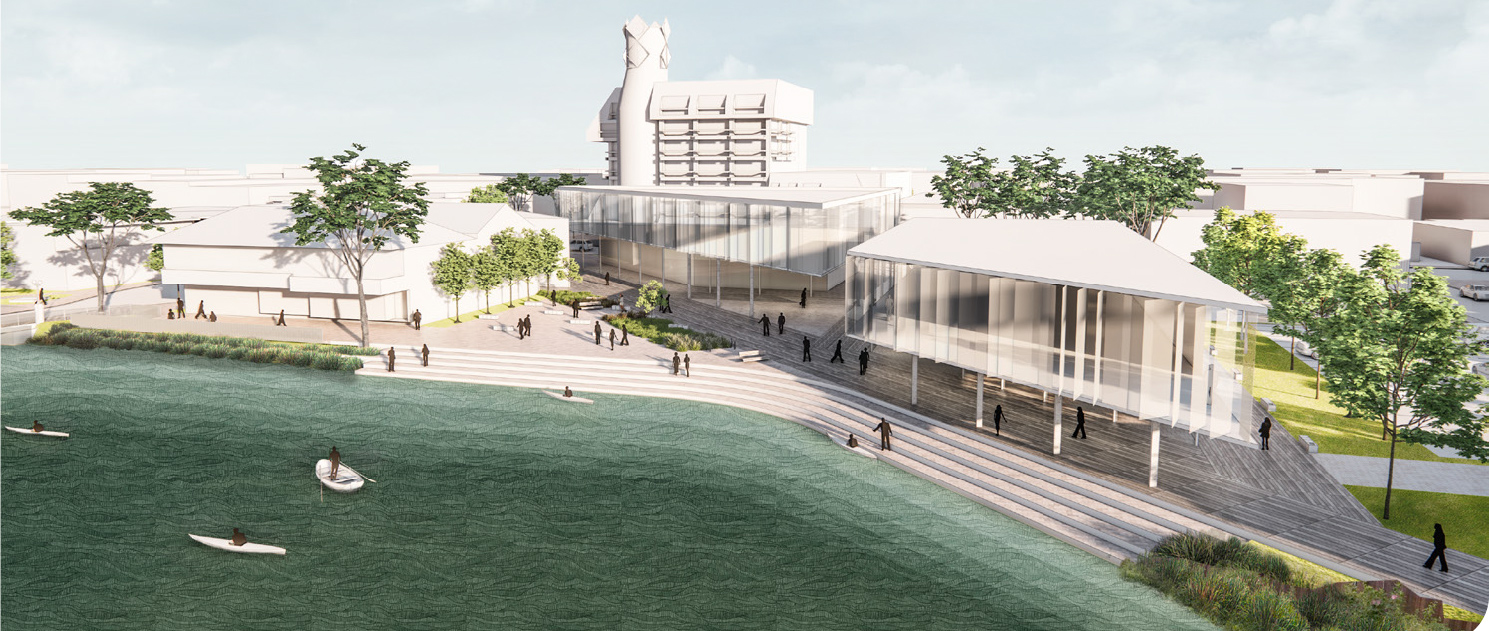Nelson’s revitalisation: Action or stagnation?


Plans for a $44.4 million library never went ahead. Photo: NCC
For years, Nelson has been plagued by indecision – putting off ambitious projects that might develop the city into one that matches its aspirations. Does the council’s latest initiative – a ‘revitalisation summit’ and its keystone development hold any hope for the future? Charles Anderson reports.
The list of what might have been is long. A redeveloped waterfront, a new city centre plan, a performing arts centre, a new library, central city playground, innovation precinct, an inner city mall… or two. Even bold plans to redevelop Bridge Street fell to equivocation – a two-lane redevelopment for a street that was already… two lanes.
Over the last 20 years, Nelson has had the opportunity to invest in projects that might have allowed the city to live up to its potential. At each stage, however, each of those has fallen over. Either baulking at the cost, changes in government, momentum getting tied up in red tape, or a general concern that Nelsonians need an abundance of parking. It is hard to make things happen. This has led to an air of inevitably around such discussions. That anything that might invigorate the city and put it on par with other similar-sized regions, which have followed through with their bold plans, will simply dissipate.
Look at any town or city around the country and each will have their own list. But Nelson, it seems, has a particular penchant for losing innovative projects that look to the future. Focusing on the here and now, on imminent rates rises, on political capital, or divisions around the council table, have all had their impact on what might have been.
The latest initiative to turn that tide was a ‘revitalisation summit’ held earlier this year, which brought councillors, developers, project managers, property owners, retailers and other stakeholders together to take another look at how that bottleneck might be broken.
It came with a grim prologue. Before it was announced, Nelson dropped to last place again in the latest ASB regional economic scoreboard, after coming second to last in the previous quarter, and last in the quarter before that.
Housing values helped cement the region in 16th place, with house prices falling 3.7% in Nelson over 2023, and house sales dropping 8% – the worst result within the data. Nelson also posted the biggest decrease in retail sales values, of 5.7% year-on-year.
So, on a March morning, key figures from big and small organisations from both the private and public sector packed out the 130-capacity gathering in the Trafalgar Centre’s northern extension for the City Revitalisation Summit hosted by Nelson City Council. Would this be different? Would something come out of it?
“We, as a group of thinkers and a group of leaders, can get some stuff done,” was the call from council CEO Nigel Philpott.
But he was quick to follow up with a dose of realism.
“Now, I'm not gonna stand here and say we're going to fix everything… Because this is easy to promise. And it won't always work. But we can give it our best shot and make sure that we are talking about ideas so that we can develop them going forward.”
Dean Croucher of TwentyTwo, one of the country’s leading property advisers, was contracted for its analysis of the predicament and laid out the main thrust of the summit. “Council owns and operates two key facilities that are in need of reinvestment.” These are the Elma Turner Library and Civic House.
“While they may look like they've got plenty of life left in them, both assets have significant obsolescence and are increasingly expensive to maintain and have inherent limitations compared to modern facilities.”
The library has been the subject of much debate over the last few years. At one point a $44.4 million project was hyped to become the lynchpin of a revitalised city centre. The resulting designs showcased a modern building that would act as a civic centre, with spaces not just for a traditional library but also to create an area where people would actually gather in the central city. It was bold, ambitious and expensive. It didn’t go ahead. The brakes were put on due to fears of the impact of climate change and its position alongside the Maitai.
So we are left with the current library building. It was closed in June 2022 after the discovery of heavy tiles in its ceiling that posed an earthquake risk.
The ceiling grid of some parts of the building was found to be under the 34% threshold of the New Build Standard (NBS).
Two years and $2.5 million later, it reopened. “(It has) been extended and modified many times, probably even cobbled together since the original 1950 structure and is in need of ongoing maintenance and reinvestment,” Dean said.
“And it was also not designed as a contemporary library or community facility. The recent investment of $2.5 million to strengthen the building only really extends its life for about 10 years. So at some point, council has to make a decision.”
Alongside this was the need to redevelop Civic House. “The building does not provide a modern workplace for staff, and is inconsistent with the workplace strategy adopted by council,” Dean said. “There's also inadequate public meeting rooms, and these are difficult to access. Now, there's been various proposals over time to upgrade and renew Civic House, they've all been considered unaffordable, and even with considerable investment, they may result in suboptimal solutions.”
The cost to redevelop it was estimated at close to $50 million. The current council long-term plan has about $65 million to redevelop both the civic centre and library, so any decision would need to be put again to council to place into future long-term plan discussions. The council then confirmed that the 2024-2034 Draft Long Term Plan retained the money currently provisioned for a new library, community hub and refurbished civic centre.

But the time was now ripe, Dean said.
“Now the continued renewal and rejuvenation of the CBD is clearly a strategic priority for council. That's obviously why we're all here today. And while this image may indicate the city centre is thriving, we know that as you walk further down Trafalgar Street, and certainly down some of the side streets, there are retail vacancies, and there are buildings that need reinvestment.”
So what was proposed was to tackle all of these issues together. By combining a new library and community hub with civic offices, elected member facilities, and a customer service centre, it was suggested the plan offered a strategic blend of innovation and practicality that endeavours to enhance service delivery, modernise essential infrastructure, and revitalise the city centre.
TwentyTwo suggested that such a development should include modern library facilities, informal learning spaces and activity areas. There would be multifunctional spaces for all kinds of events and functions. There would be an inviting space for the community, revenue generating operations like a café or bookable meeting rooms, a conference area and a customer service area.
The space needed for such a project was put between 3,500 and 4,000sqm. It should also be delivered within five years of council’s approval of the indicative business case.
The issue, of course, was where such a space might be found. The areas suggested were the current library site, Millers Acre, Achilles Avenue adjoining Wakatu Square, and 25-27 Bridge Street. However, due to the climate change issue, Achilles Avenue was suggested as potentially the only suitable site, but this only gave 2,760sqm.
A variety of options were put forward, from leasing buildings to constructing new ones, to buying back previously owned buildings or splitting the project across various sites. The costs for these ranged between $50 million and $90 million.
While splitting the site and leasing options were considered, Dean said the initial work done for the business case indicated that a facility funded, owned, and developed by the council was more economically viable in the long term because of the lower cost of capital.
Should the council fund, develop and own the facility, that would include an estimated $5 million for land, $65 million for the building, and a fit-out of around
$25 million, totalling in the order of $90 million, with leeway of $10 million.
To test a council-led solution as opposed to council leasing a facility, it would have to develop both options in more detail and obtain competitive responses from the market.
Mayor Nick Smith wanted to emphasise that our council has made no decision on the report. “Today's purpose is to receive it and to release it and for our community to be able to digest. Any major sort of project of that sort needs a long runway, and also requires a large amount of community engagement. It needs to be clear: no site's been identified.”
The council moved forward with the report’s recommendations. It established two new taskforces to help guide the progress of key city projects – the revitalisation of Nelson’s city centre, and the waterfront redevelopment. Mayor Nick says the taskforces will provide governance oversight for major investment in the city and serve as a forum for investigating and prioritising the many ideas that came from the City Revitalisation Summit.
“These new taskforces are about building on the momentum from the summit with the right structure and teams to translate the ideas from it into action.” Its mandate was to deliver on the call for new investment in the central city.
“The next step, now council has approved the taskforces, is to get to work on the dozens of ideas that came from the summit,” Mayor Nick says. Deputy Mayor Rohan O’Neill-Stevens said, “our city is already a vibrant place. Our job is to amplify and enhance that and deliver to the full extent of its potential.”
Discussions with What if Whakatū Nelson group are underway regarding the establishment of a community-led taskforce. The taskforce would not be administered by council, but council will assist with its terms of reference and membership.
Taskforces are one thing. Decisions and follow through are another. Such projects only become more expensive. Inevitably, they also feature cost blowouts.
So the question remains, will these taskforces make progress on what has previously been an apparent immovable force?
As Nigel Philpott said: “I want to get some stuff done. I don't want to be talking in five years about what we could have done, I want to be talking about what we have done.”
The summit featured a lot of talk. That talk now needs to become action. Because then the idea for a new civic centre, complete with all the facilities that might help convince Nelsonians that there is hope for the city, would just become another bullet point in that long list of lost projects.
Time will tell.
